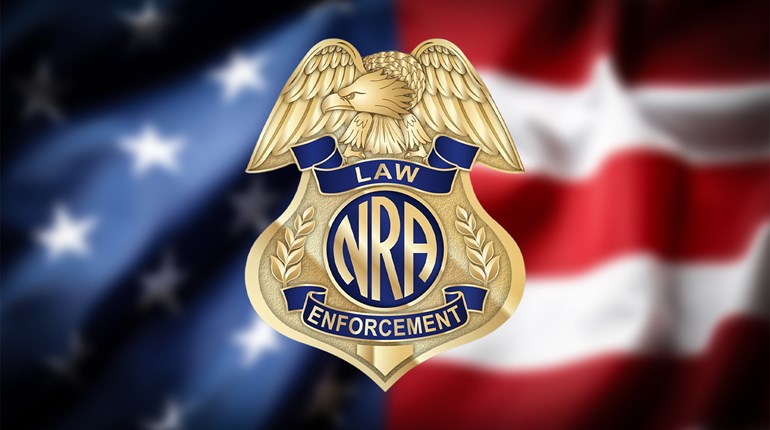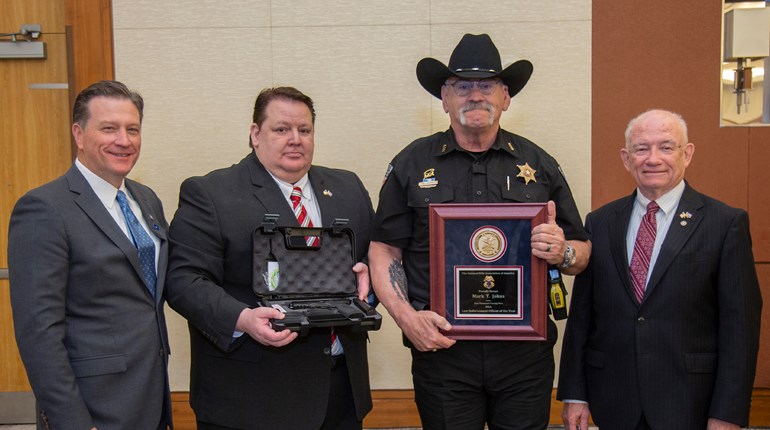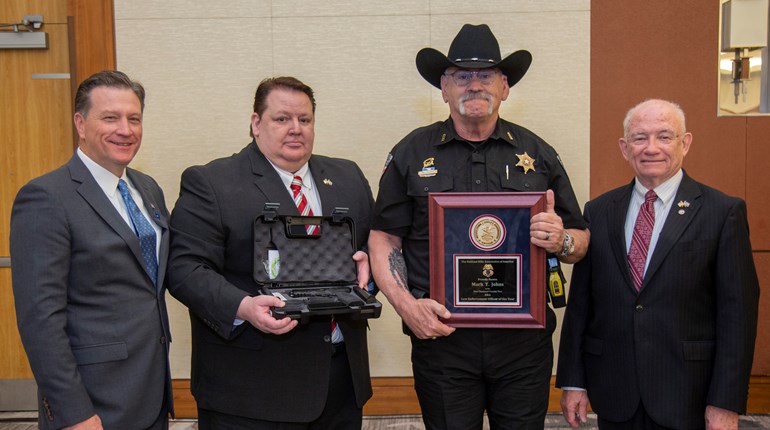
Tulsa Police Department Sgt. Mike Parsons is the NRA’s Law Enforcement Officer of the Year. His story should help us reset how we view police nationwide.
I run into national 3-Gun champion Dianna Muller in a noisy Indianapolis hotel lobby. “Come with me, I want you to meet somebody,” she says.
We snake our way through a seating area jammed with National Rifle Association members from the far corners of the country for the year’s most significant gathering of gun owners. She leads us to a knot of people crowded into a corner of the room, where she leans in to talk into the ear of a graying man of medium height and build. She turns back to me, again leaning close to be heard: “This is my friend Sgt. Mike Parsons, the NRA’s Law Enforcement Officer of the Year.”
Sgt. Parsons leans closer to shake hands and smiles as we exchange greetings. He isn’t there to impress you; he speaks calmly and listens closely. He’s exceedingly polite and friendly. He introduces me to his wife, Danielle, a fit and pretty brunette who shakes my hand with a big smile.
I congratulate him, and he deflects credit to his team, to his wife, to God. Going in, all I know about his story is that he suffered a gunshot wound, so I inquire about his recovery; he shows me a photo of his injured thigh from his cell phone.
As he talks, he fishes in his pocket; out of it he produces a shiny challenge coin, deformed by a prominent dent.
On a hot July day in 2018, the gang unit of the Tulsa Police Department was patrolling an area known for gang activity. At a hotel known to the TPD, they engaged a young man standing next to a woman in a minivan. The man refused to identify himself, as was his right. However, as the pair left, a motor vehicle check revealed the license plate didn’t belong to the minivan. The unit followed them until they stopped for gas at a convenience store.
When the woman went inside, officers found the young man in the back seat. Asked again for ID, he would only identify himself as “Junior.” However, the mismatching plates now empowered the unit to investigate. Now, they told Junior, he was obstructing an investigation.
Junior refused the team’s repeated requests to exit the van. The woman, now identified as his girlfriend, refused to budge from the van’s open sliding door, a flesh-and-bone barrier to peaceful resolution. Two pit bulls paced back and forth in the rear of the van. The situation grew more tense: A busy gas station is no place for a gunfight.
Junior escalated the confrontation, demanding to speak to a “general, or sergeant, or captain.” After several minutes of unproductive engagement, they placed a call to Sgt. Parsons for help.
TPD officer Con Erickson heard the call and headed toward the convenience store. He and Parsons are close friends: “He and I had been involved in several high-stress events,” Parsons said. “We bonded as a result.”
One of those events was a call “that just went real bad,” Erickson said. He was involved in an altercation with a man who “had a lot of stuff in his system that didn’t need to be there,” a phrase that needs no further explanation. The suspect had to be taken to the ground to subdue him. Ultimately, his body was too “ramped up” to survive the fight.
“Mike was the first officer there to help me. I was pretty emotional: I initially went there to help this individual, and it ended up in a fight that ended this gentleman’s life.” Erickson recalled how Parsons called every day to make sure he was ok, to make sure his family was ok, to see if he needed anything.
Erickson became a medic to save lives, not take them. His brother and sister both died partially as a result of a lack of experienced medical help. He resolved to do everything he could to make sure “everyone goes home to their families.”
Parsons’ support was invaluable to Erickson. “I wanted him to have something that showed my appreciation for his efforts,” Erickson said.
Parsons recalls Erickson “chose to give me a coin that he got after he had been promoted in the Navy.” After 18 years as an enlisted man, Erickson received his commission as a Naval officer, and he received the coin to commemorate his selection. “That coin meant a lot to me,” Erickson said. “Eighteen years is a long time.”
Erickson received one coin to signify 18 years of his life’s work. In gratitude, he gave it to his friend, Parsons, to carry with him at all times.
At the convenience store, Officer Mike Cawiezell was relieved when Parsons arrived. “I see it’s Mike, and the first thought that went through my mind was, ‘This is exactly the guy I want here.’” In addition to Parsons and Erickson, Officers D.K. Bishop and Albert Cabellero were en route. When he saw Parsons, Officer Danny Bean recalled thinking, “Great, now we’ll get this guy out of here.”
Parsons went over the options: “Fighting a suspect in a confined space is obviously much more dangerous, both for them and for us. Making that person leave that space and come to the officers is what’s safe. You don’t know what’s in that car.”
Parsons was armed with a pepperball gun, a pistol that uses compressed CO2 to fire a .68-caliber projectile containing 3 grams of PAVA powder. PAVA is a pharma-produced incapacitating substance similar to pepper spray. It produces a burning sensation, watery eyes and a runny nose. It washes off with water, shortening recovery time significantly. Parsons’ pistol was fitted with a split-shot attachment, a blade at the muzzle that carves the projectile in two. This creates a larger cloud that contaminates the space and encourages the suspect to exit.
The time for negotiating was over. Parsons calmly stood in the opening of the van while the girlfriend was persuaded to move, escorted out of harm’s way by Officer Bishop. Parsons’ steady voice gave the command: “Pepperball, pepperball, pepperball,” and he began firing projectiles into the van’s interior, one after another.

Gunfire erupted from inside the van, scattering the officers. They returned fire while sprinting to find cover—all but Parsons, who lay on the hot concrete before the opening of the minivan.
The next minutes were pandemonium: officers shouting, girlfriend screaming, customers in the line of fire. The shooter was invisible within the darkness of the minivan, and the man in charge was on the ground, injuries unknown. The scenario threatened to spiral out of control.
Responsible for the female suspect, Bishop saw Parsons go down out of the corner of her eye. Her training directed her next actions: “Get to cover, get her taken care of, and then go see how bad it is.” The stunning significance of her response will become apparent later.
Erickson arrived to find Parsons down; he and Bishop pulled him to safety behind a vehicle. When they helped him to his feet, Parsons’ leg felt like it had been hit with a baseball bat. “You’re trained that if you get shot, you’re not dead, you just got shot,” Cawiezell said matter-of-factly. “Keep going.”
Once erect, Parsons commanded the officers to remain calm: “Panic was not a choice that day.” He took charge again: “Listen to me! Does anyone have a shield?” Teaming officers behind shields, Parsons directed the unit to advance on the minivan. In the dim interior, they could see the suspect searching for his gun.
As they closed in, Erickson told Parsons, “If he gets that weapon, I’m going to kill him.” Parsons replied, “That’s an option, but we’re going to move back.”
Parsons commanded the unit to back off to avoid more gunfire. “There are times when deadly force is legal, lawful and appropriate, and we could have gone either way. But for me, enough is enough. We can do this in a safer way.”

If there was ever a time when deadly force was justified, this had to qualify. Parsons’ attitude will shock some readers: “We’re responsible for the suspect. If we can take him into custody safely, then that’s what we need to do to provide aid.”
Contrast that statement with the common depiction of cops in the national media, where they are often smeared as trigger-happy racists. That portrayal withers before the example set by Sgt. Parsons, rising wounded from the pavement of a gas station on a scorching Oklahoma day.
Instead of reducing the minivan to salvage in a hail of bullets, Parsons’ team again used pepperballs to drive the suspect out of the minivan. Each team member moved to cover an angle or restrain a limb, every detail choreographed by Parsons himself. Together, they cuffed the suspect and Erickson began to treat him for two gunshot wounds.
“The suspect was saved by the officer he tried to kill,” Erickson said.
With the scene secured, Parsons finally hobbled to a nearby ambulance for aid. Though a team of emts was waiting to treat him, he called for his friend, Erickson.
“I see the entry hole clear, I’m feeling his leg and I’m checking for swelling,” recalled Erickson. “Some guys bleed out in two, two and a half minutes. You don’t have much time at all. I see where it hit close to the artery and that big bone right there ... there’s gotta be something that I’m missing here.”
There was. As Erickson cut away the pant leg of Parson’s uniform, the bloodied coin he had given him fell out onto the pavement, its symmetry forever ruined by the impact of the bullet.

A week after returning from Indianapolis, I viewed a rough cut of the episode of “Oliver North’s American Heroes” featuring Sgt. Parsons. The stunning body camera footage places you in the middle of Parsons’ team at that gas station. As I watched events unfold, it dawned on me that I’ve met officer D.K. Bishop. She is the smiling woman from that hotel lobby in Indianapolis—Danielle Bishop, Parsons’ wife of 23 years, mother of their three children and the officer who helped drag him to safety in his most desperate moment.
“Really, Danielle and Con coming to get me, that’s the most heroic thing that day,” Parsons said. “For Albert and Con and Danny and Mike to all stay engaged right there, when you have somebody who’s already shown a propensity for violence, that’s dedication to duty. That’s courage. It didn’t work out necessarily the way I envisioned it in my head, but I think it worked out very well.”
For his sacrifice, courage and empathy, the NRA was proud to name Tulsa Police Department Sgt. Mike Parsons as its Law Enforcement Officer of the Year for 2019. Thank you, Sergeant, and be safe.


































